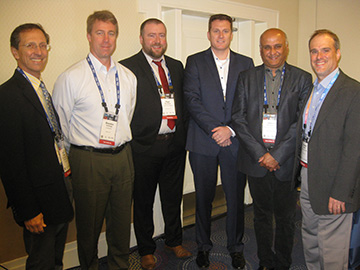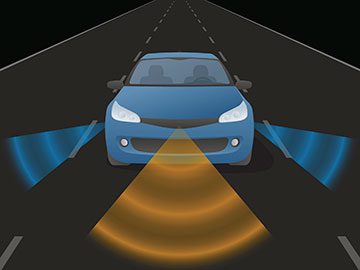![]()
Self-driving cars are coming to our highways in the not-so-distant future, but how will these vehicles view their surroundings? At what wavelengths will the automotive sensors scan the streets ahead of them?
The special automotive track at this year's Frontiers in Optics/Laser Science conference brought together a spectrum of viewpoints on the nascent industry of road-sensing technologies. Researchers and executives from lidar manufacturers presented a range of concepts for adding practical light-ranging technology to automobiles. A Monday afternoon panel brought together representatives from optics vendors, an automaker trade group and a regulatory agency to weigh in on the practicalities of implementing self-driving systems.
Different flavors of lidar
Virtually everyone in the industry (except Tesla, Inc., according to one presenter's slide) believes that lidar will play an important role in the sensing component of self-driving cars. However, the companies that are actually developing lidar for autonomous vehicles—systems that incorporate as much artificial intelligence (AI) as they do optics—don't agree on what the standard automotive lidar of the future will look like: active or passive, wavelengths of 900 nm or 1550 nm, different types of solid-state lasers.
Studies of the human brain show that the visual cortex takes steps to ensure we are not overloaded with excess data, said Barry Behnken, senior vice president of AEye Inc., USA. Yet current sensing systems generate so many terabytes of data per hour that 70 to 95 percent of it must be discarded due to irrelevance or time constraints. Behnken's company—based in Silicon Valley and backed by venture capital—uses AI to identify regions of interest within the lidar's field of view and prioritizes the processing of that data.
Lidar technology based on 900-nm-wavelength lasers will soon “run out of gas,” said Mark Itzler of Argo AI LLC, USA. His company is designing lidar systems that incorporate single-photon detection with Geiger-mode avalanche photodiodes (APDs). Because lidar systems based on lasers operating at wavelengths longer than 1400 nm don't carry the same eye-safety concerns as their 900-nm counterparts, the lasers can use more energy to achieve a lidar system range much greater than 200 m.
Diverging markets

Panelists who discussed optics for self-driving cars at Frontiers in Optics/Laser Science. Left to right: Kevin Dopart, U.S. Department of Transportation; Brandon Collings, Lumentum; Paul Scullion, Global Automakers; Rob Murano, II-VI Photonics Inc.; panel moderator Sabbir Rangwala, Patience Consulting LLC; Shawn Esser, Finisar Corp. [Image: Patricia Daukantas]
Angus Pacala, co-founder of the startup Ouster Inc., USA, said that the automotive lidar market has diverged into two markets: one for autonomous and robotic vehicles and another for consumer-oriented advanced driver-assistance systems (ADAS), like the parking-assist systems already in some of the latest U.S. cars. The test for a consumer-oriented system is whether it fits into a car's bumper.
Unlike other session speakers who advocated indium phosphide and related semiconductor detectors, Pacala championed silicon single-photon avalanche diodes (SPADs), which he said will improve sensitivity by a factor of 10 to 30 over the next five years.
Ouster is already delivering a flash-lidar system that can see up to 140 m, which Pacala admitted wasn't for fully autonomous vehicles on a busy highway. The company plans to release a second-generation system later this year.
Taking a “realistic” view
Scientists and engineers generally grade vehicle autonomy on a six-step scale, with Level 0 having no autonomy (the human driver does everything) to Level 5 having full autonomy (completely driverless). According to U.S.-based consultant Sabbir Rangwala, moderator of the panel on “A Realistic Assessment of Optics for Self-driving Vehicles,” the consensus is that lidar will be essential for the three levels of greater autonomy.
Among the 70 or more companies already involved in automotive lidar, Rangwala said, some are vertically integrated, meaning that they develop the system laser, detector and associated optics themselves. Others rely on outside suppliers. But all are pursuing a market that is expected to be US$1.4 billion in 2020 and US$9 billion in 2030, just for the lidar equipment.
Regulatory diversity
The United States probably won't impose nationwide regulations on self-driving cars anytime soon because it doesn't want to squelch innovation, said Kevin Dopart, program manager for intelligent transportation systems at the U.S. Department of Transportation (USDOT). However, he added, cities and states may choose to implement their own regulations. (In the United States, individual state governments handle motor-vehicle registrations, and virtually all those state laws were written before the concept of driverless cars came into being.)
In the United States, auto manufacturers must self-certify the safety of their product designs, according to Dopart. However, USDOT's National Highway Traffic Safety Administration retains the authority to recall vehicles for potential hazards, so it is in manufacturers' own interest to make safe products.
Finding focus

How will optics companies decide where to focus their efforts in self-driving technology? Shawn Esser, director of the product management division of Finisar Corp., USA, said his optical-communications firm will look for partners that have a solid backing within the automotive industry. Brandon Collings, chief technology officer of Lumentum Operations LLC, USA, said his company's business model is volume manufacturing of optical components, so it would seek partners accordingly. “This is more of an engineering and business challenge than a technology challenge,” he said.
It's not yet clear whether car manufacturers will adopt identical requirements for lidar systems, said Paul Scullion, a panelist representing a trade group called Global Automakers. Panelists generally agreed that standards will eventually emerge, though such standards often emerge when one company grows to dominate the market, as Microsoft did with its desktop-computing operating systems.
More on the FiO 2018 automotive track
The conference's automotive-technology track began with a broad overview of the challenges in automotive lidar development by Jan-Erik Källhammer of the Swedish sensor-technology company Veoneer Inc. The track continued on Tuesday with two additional panel discussions: one on vehicular autonomy in realistic weather situations—timely, given the recent storm that hit the U.S. East Coast—and one on how cars of the future will “see” unstructured environments. The Science & Industry Showcase floor is also hosting live demonstrations of a vehicle-mounted lidar sensor.
